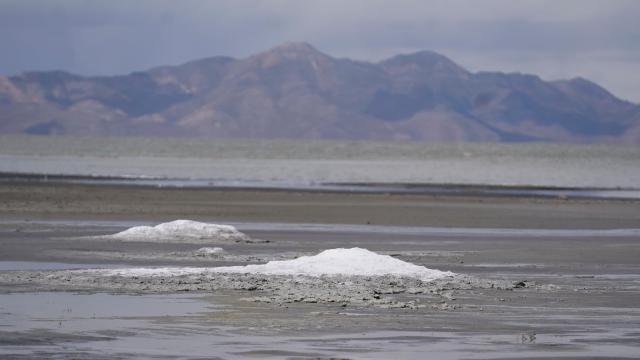The only thing protecting the state of Utah from toxic, arsenic-filled dust storms is the expanse of saline water known as the Great Salt Lake. But bad news: The lake is rapidly drying up. It’s currently sitting at its lowest recorded water level ever, which was first recorded on Sunday.
The lake’s average daily surface water elevation (i.e. the height of the water above sea level) is now 1,277.14 m, according to the United States Geological Survey. For context, the historical average since measurements started in 1847 has been about 4,200 above sea level, so the Great Salt Lake has lost nearly 3.05 m of elevation. For even more context, the lake is only about 9.14 m deep at its deepest point. The lake’s surface area once encompassed about 3,300 square miles in the 1980’s. Now, it covers less than 1,000.
“This is not the type of record we like to break,” Utah’s Department of Natural Resources director, Joel Ferry, said in the press statement.“Urgent action is needed to help protect and preserve this critical resource. It’s clear the lake is in trouble. We recognise more action and resources are needed, and we are actively working with the many stakeholders who value the lake.”
Normally, without human intervention, Great Salt Lake would go through seasonal cycles of water loss and replenishment — evaporating in the summer and filling back up with rain and snowmelt in wetter months. Yet many of the tributaries that previously drained into the shallow lake basin have been diverted to fulfil industry, agricultural, and other human uses. Utah is the fastest growing and second driest state in the country, and one 2017 study found that human consumption has reduced the Great Salt Lake’s volume by about half of what it would be otherwise.
On top of that loss, the ongoing megadrought in the Southwest means there’s less water all around than there has been any other time in the past 1,200 years. 100% of Utah is currently in a state of drought, and almost 83% is experiencing extreme drought, according to the National Drought Monitor. One 2022 study attributed 42% of the past 22 years of drought conditions to climate change.
This new record low is unlikely to be the last for the summer. Lake levels will probably get worse before they get better, noted the USGS. Evaporation rates from the lake are highest in the summer and fall.
As that lake bed dries up, the possibility of toxic dust storms intensifies. Decades of mining surrounding Great Salt Lake means heavy metals, arsenic, and other bad-to-breathe compounds have been piling up below the surface. Even when the water recedes, most of that harmful dust is held back by a hardened crust, but wind wares down that crust over time, and it’s already cracking.
Thousands of miles away, there’s a vision of what Utah’s future could look like. The Aral Sea in Uzbekistan and Kazakhstan was diverted down to near-nothing for agricultural irrigation starting in the 1940s. What remains is a toxic desert with dust that poisons nearby inhabitants. The communities that remain surrounding the lake suffer from unusually high rates of cancer, kidney diseases, and infant mortality.
And, beyond that increasingly possible nightmare scenario, the Great Salt Lake’s decline has other negative impacts too. Between tourism, mineral extraction and a thriving brine shrimp (AKA sea monkeys!) industry, the lake has huge economic value for Utah. Its total combined, direct annual output is about $US1.53 ($2) billion, based on data from a 2019 state analysis — and that’s not even accounting for the indirect value of things like ecosystem services, and the public health costs and consequences of allowing it to dry up.
Then, there’s the environmental and wildlife implications of a shrinking Salt Lake. Millions of migratory birds, for instance, rely on the lake as a stopover site on their long-distance journeys.
To preserve the lake, it’s obvious that more water needs to be redirected back into Utah’s briny bowl. State lawmakers and Governor Spencer Cox have sort of been taking the problem seriously, but maybe not seriously enough.
Earlier this year, Gov. Cox declared a temporary state of emergency due to the drought, which lifted in June. And there’s been a bevy of recently proposed and adopted water conservation legislation. Yet many important water conservation measures (like prohibitions on lawn watering) were struck down in the same legislative session, and special interest groups — determined to keep the water flowing — hold lots of sway, according to a ProPublica report.
Instead of making the tough compromises, state legislators are considering some more out-there proposals, like a pipeline to carry water from the Pacific Ocean.
However, even if Utah did adopt every single practical water saving measure on the docket, the state likely can’t save the lake alone. Much of the water that should be going to the Great Salt Lake is used up before it even crosses the Utah border. Water rights to the Bear River, the largest tributary of the lake, are shared with Idaho and Wyoming. Then, again, there’s climate change, deepening drought and accelerating evaporation.
The fate of the lake (and millions of peoples’ lungs) is up to Utah, yes. But also its neighbours, and also the country, and also the world.
